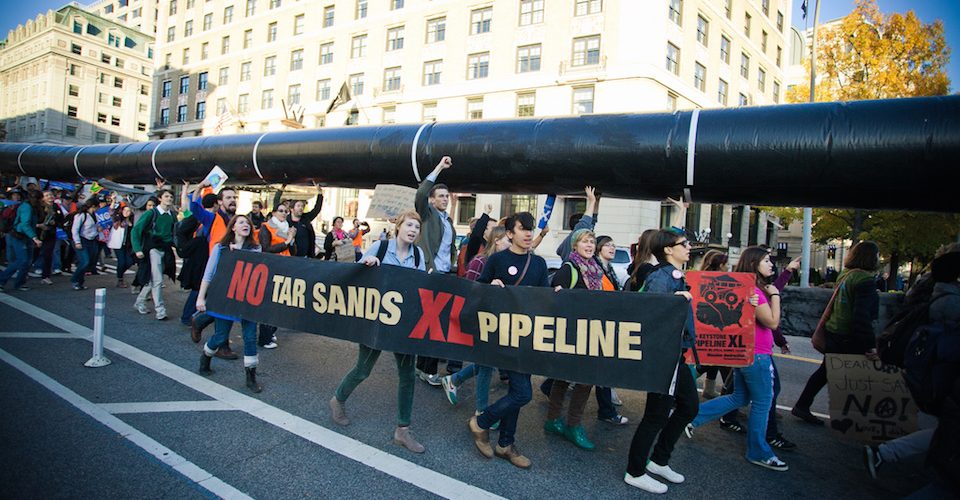Back in January of this year, The New York Times published an article detailing how the campaign to stop the Keystone XL pipeline had “changed American environmental politics.” For over three years now, thousands of people have marched, rallied, commented, blockaded, been arrested and done almost everything in between to stop this project.
Back in January of this year, The New York Times published an article detailing how the campaign to stop the Keystone XL pipeline had “changed American environmental politics.” For over three years now, thousands of people have marched, rallied, commented, blockaded, been arrested and done almost everything in between to stop this project. Today, the pipeline remains without a permit, with piles of pipe collecting dust all along the pipeline route, and a stronger grassroots climate movement than we’ve ever seen in the US.
Now TransCanada, the company behind the Keystone XL, is setting its sights on a new project, Energy East. Bigger than Keystone XL, TransCanada’s new Energy East project would be the biggest tar sands pipeline proposed yet, moving over a million barrels a day from Alberta to the Atlantic Ocean. There are a few important lessons that can be taken from Keystone XL and applied to slow or stop Energy East.
RELATED: 9 Ways to Fight Fracking: Lessons from the front lines in New Brunswick
1. Direct Action Gets the Goods
What we learned: Our first foray into the Keystone XL campaign happened in August 2011 when over 1,200 people were arrested over two weeks in Washington calling on President Barack Obama to reject the Keystone XL Pipeline. First Nations and Indigenous people sat down in front of the White House next to Nebraskan farmers, baby boomers, students and Obama campaign staffers. At this point, the project was considered by most people — from politicians to pundits, to some of our own allies — to be a done deal. We knew that to change that narrative, we needed to do something big and bold, and so Tar Sands Action was born.
Tar Sands Action and the activists who had been arrested in DC continued building momentum across the US, occupying Obama campaign offices, interrupting Obama campaign speeches, organizing strategy sessions in college classrooms and living rooms across the country, and building toward a massive mobilization in DC a few months later where over 15,000 activists came to DC and encircled the White House.
What it means: This introduction to direct action ended up being exactly the excitement that was needed to revitalize and fuel the climate movement. Granted, it was not a huge sacrifice for most of the people who chose to risk arrest. Aside from the first batch of arrestees who were held in lockup for 3 days in poor conditions, the consequence of sitting-in was a $100 citation and an immediate release. However, the excitement and camaraderie created by the action activated hundreds of new leaders across the country. Those people started or joined fights against the fossil fuel industry and started climate activist groups on their campuses. But most of all, this tactic normalized direct action within the environmental and climate movements, and opened the door for many more actions and activists to risk arrest down the line.
2. Embrace Unlikely Allies
What we learned: Starting with the original tar sands action at the White House, and throughout the entirety of the campaign, the campaign to defeat Keystone XL has brought together unlikely allies. Starting with the sit-ins at the White House, and extending to a massive tipi encampment on the National Mall in DC organized by the Cowboy Indian Alliance, the campaign has consistently highlighted the diverse array of voices that would be directly impacted by the pipeline.
In addition to highlighting those voices, there have been consistent youth voices, both from college students and past Obama for America campaign staffers who have called on the President to reject the pipeline for their futures and the future of the climate. Vote NOKXL in Massachussetts did massive voter turnout focused on turning out anti-Keystone XL young voters, and in March of 2014, a thousand college students again took to the streets of DC in an action called XL Dissent, where 400 of them got arrested at the White House fence. This diversity of voices consistently calling on Obama has built a steady drumbeat of pressure from all sides.
What this means: The Energy East pipeline crosses six provinces along its 4,400-kilometre route. From the prairies to the rocky shield and the coastline of the Bay of Fundy, this pipeline presents an opportunity to dig deep and built a vibrant and diverse movement to stop it. Already voices from farmers to fishermen are speaking out in opposition, and for organizers it means embracing allies that we may have never worked with before, but also methods of organizing that may seem foreign to us.
For example, before Energy East can be built it needs to win over Quebec, where just two years ago students organized the largest sustained mass mobilization Canada has seen in decades. Already, a coalition of student associations representing nearly 100,000 students in Quebec is coming together to oppose Energy East. By supporting this organizing and building an alliance between students and the climate movement, the fight to stop Energy East could grow even larger and more powerful.
3. Talk About Climate Change
What we learned: When the Keystone campaign started, the climate movement in the United States was in a difficult place. We had come through the collapse of Copenhagen, followed by the failure of a major piece of US climate legislation. The political discourse on climate had been clouded by the denial industry, and for many climate change had become a dirty word.
We hoped that the Keystone campaign would not only be a chance to reinvigorate environmental action, but also an opportunity to start talking about climate in a new way — one that directly linked climate change to push to extract extreme energy like the tar sands. We needed to talk, unashamed and unafraid, about climate at a time when the dominant thought was that it was too abstract to galvanize real action. But by making the climate case over and over, the Keystone has now become a litmus test for climate leadership at the highest level of the US government.
What it means: The Energy East pipeline has a climate impact the same as 7 million cars, and is poised to be the key to industry unlocking a new phase of tar sands expansion. That means this pipeline is both a symbolic and literal lynchpin in plans to expand Canada’s fastest growing source of greenhouse gas emissions. The pipeline also will get no review on climate change under current rules. With politicians in Canada content to deliver talking points on climate with no real action, this means that there is a golden opportunity to make Energy East a climate test, and force real action on climate and tar sands expansion in Canada.
4. Support Indigenous Rights
What we learned: Tar sands expansion – and hence pipelines – is inherently an issue not just about climate, but also about the rights of people to say no to dangerous development — especially Indigenous peoples in Canada and US tribes along pipeline routes. As the fight against Keystone has grown, frontline community leadership has been fierce, dedicated and one of the strongest tools for stopping this project.
Working on Keystone has also meant learning a lot as we go, especially about just how far and wide the impacts of tar sands development reach, from the pipelines to the refineries and all the way back to the source. Of course, all along the way there have been stumbles and mistakes, probably most of all in relation to working with communities on the front lines, but working with and supporting these communities has also built some of the most powerful alliances and local campaigns the climate movement has ever seen.
What this means: The Energy East pipeline impacts over 150 Indigenous communities in Canada, and as we’ve seen with other pipelines in Canada, the rights of these communities are one of the biggest challenges to extreme energy development. These rights though, cannot just be seen as a strategic tool by campaigners, but rather an imperative to work with and support Indigenous communities in both stopping Energy East, but also the longer, deeper and even more important work of building alliances and relationships grounded in confronting the ongoing impacts of colonialism.
5. Be Relentless
What we learned: Most people know about the big actions that have punctuated the Keystone XL fight, but fewer have heard about the hundreds of smaller, local actions that have really made it happen. For the past two years a constant thrum of organizing and actions have harried Barack Obama, with local actions “bird-dogging” the president’s events across the United States and even all the way to Europe. Local actions have also been the backbone of a rapid response network that has organized hundreds of actions, many with next-to-no notice, and some that have helped to bolster and uphold a legislative firewall against Keystone.
What this means: The Energy East pipeline is the longest tar sands pipeline ever proposed, and that means all along it are hundreds of communities that can be organized to take action to stop this project. Already, organizers have been staging a steady stream of protests at TransCanada’s open house events along the route; now we need to weave these localized pockets of opposition into a powerful, cross-country movement to stop Energy East.
You can get involved by joining the newly launched Energy East Action Network.
Cameron was born in Edmonton, AB, is the former director of the Canadian Youth Climate Coalition and currently works as the Canadian Tar Sands Organizer with 350.org.













